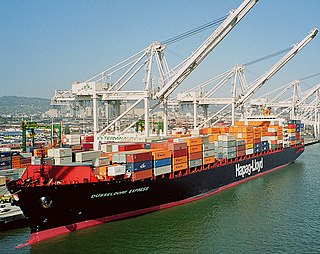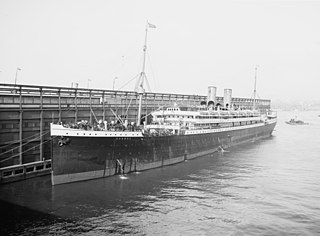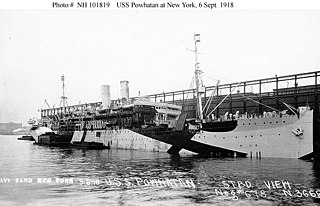
Hapag-Lloyd AG is a German international shipping and container transportation company. Hapag-Lloyd was formed in 1970 through a merger of Hamburg-American Line (HAPAG) and North German Lloyd.
Norddeutscher Lloyd was a German shipping company. It was founded by Hermann Henrich Meier and Eduard Crüsemann in Bremen on 20 February 1857. It developed into one of the most important German shipping companies of the late 19th and early 20th centuries, and was instrumental in the economic development of Bremen and Bremerhaven. On 1 September 1970, the company merged with Hamburg America Line (HAPAG) to form Hapag-Lloyd AG.

CP Ships was a large Canadian shipping company established in the 19th century. From the late 1880s until after World War II, the company was Canada's largest operator of Atlantic and Pacific steamships. Many immigrants travelled on CP ships from Europe to Canada. The sinking of the steamship RMS Empress of Ireland just before World War I was the largest maritime disaster in Canadian history. The company provided Canadian Merchant Navy vessels in World Wars I and II. Twelve vessels were lost due to enemy action in World War II, including the RMS Empress of Britain, which was the largest ship ever sunk by a German U-boat.
Aktien-Gesellschaft Vulcan Stettin was a German shipbuilding and locomotive building company. Founded in 1851, it was located near the former eastern German city of Stettin, today Polish Szczecin. Because of the limited facilities in Stettin, in 1907 an additional yard was built in Hamburg. The now named Vulcan-Werke Hamburg und Stettin Actiengesellschaft constructed some of the most famous civilian German ships and it played a significant role in both World Wars, building warships for the Kaiserliche Marine and the Kriegsmarine later.
Heligoland is a German island in the North Sea.

SS Vaterland was a transatlantic ocean liner that was launched for the Hamburg America Line in 1940 but left incomplete because of the Second World War. An Allied air raid damaged her in 1943, and she was scrapped in 1948.

SS Cleveland was a German transatlantic ocean liner that was launched in 1908 and scrapped in 1933. Cleveland was built for the Hamburg America Line (HAPAG) as a sister ship for Cincinnati.
Fürst Bismarck may refer to:

SS Scharnhorst was a Norddeutscher Lloyd ocean liner, launched in 1934, completed in 1935 and made her maiden voyage on 8 May 1935. She was the first big passenger liner built by the Third Reich. Under the German merchant flag, she was the second liner named after General Gerhard J. D. von Scharnhorst. She was one of three ships on the Far Eastern route between Bremen and Yokohama; her sister ships were SS Potsdam and SS Gneisenau. These three ships were planned to shorten the journey time between Bremen and Shanghai from the usual 50 days to 34. She was trapped in Japan in September 1939 and later converted into an Imperial Japanese Navy aircraft carrier named Shinyo in 1942 and sunk by US submarine USS Spadefish in 1944.

RMS Empress of China was an ocean liner built in 1890-1891 by Naval Construction & Armament Co., Barrow, England for Canadian Pacific Steamships (CP). This ship—the first of three CP vessels to be named Empress of China—regularly traversed the trans-Pacific route between the west coast of Canada and the Far East until she struck an underwater reef and sank in Tokyo harbour in 1911.

SS Prinz Friedrich Wilhelm was an ocean liner for North German Lloyd (NDL) from her launch in 1907 until the end of World War I. After the war, she briefly served as USS Prinz Friedrich Wilhelm (ID-4063) for the United States Navy returning American troops from France. The vessel was first chartered—and later purchased outright—by Canadian Pacific Steamships (CP) and operated under the names Empress of China, Empress of India, Montlaurier, Monteith, and Montnairn. She was scrapped in 1929.

The Barbarossa class was a class of ocean liners of North German Lloyd and the Hamburg America Line of the German Empire. Of the ten ships built between 1896 and 1902, six were built by AG Vulcan Stettin, three were built by Blohm & Voss, and one was built by Schichau-Werke; all were built in Germany. They averaged 11,000 gross register tons (GRT) and featured twin screw propellers driven by quadruple-expansion steam engines.

USS Powhatan (ID–3013) was a transport ship for the United States Navy during World War I. She was originally the SS Hamburg, a Barbarossa-class ocean liner built in 1899 by Aktiengesellschaft Vulkan of Stettin, Germany, for the Hamburg America Line. At the outset of World War I the ship was interned by the United States.
Lykes Bros. Steamship Co., also called Lykes Lines, was a cargo shipping company acting from the beginning of the 20th century to 2005 having its main business in the trade to and from the United States.

USS Suwanee (ID-1320) was a United States Navy transport in commission in 1919. She was the second ship to carry her name.

The Rivers class was a class of eleven ocean liners of the Norddeutscher Lloyd (NDL), the first class of German express liners. The ships were built between 1881 and 1890, the first nine in Glasgow by John Elder & Co. or the renamed Fairfield Shipbuilding and Engineering Company, the last two in Stettin by Vulcan. All were named for rivers in Germany.

SS Burdigala was an ocean liner that sailed the Atlantic Ocean from 1898 until World War I. The ship was built as the Kaiser Friedrich in 1898 for Norddeutscher Lloyd (NDL), a German shipping line. Designed to break the speed record for a transatlantic liner and thereby win the Blue Riband, the Kaiser Friedrich never achieved the necessary speeds. After a short career with NDL and an equally short period of service with NDL's main German competitor, the Hamburg-Amerikanische Packetfahrt-Aktien-Gesellschaft, the ship was mothballed for a decade. After being sold to the French shipping line Compagnie de Navigation Sud-Atlantique, it re-entered service as SS Burdigala. In 1916, while en route from Thessaloniki to Toulon, the liner struck a mine laid by the German U-boat U-73 in the Aegean Sea and sank near Kea, Greece.
A number of steamships were named Teutonia, including -
This page is based on this
Wikipedia article Text is available under the
CC BY-SA 4.0 license; additional terms may apply.
Images, videos and audio are available under their respective licenses.











